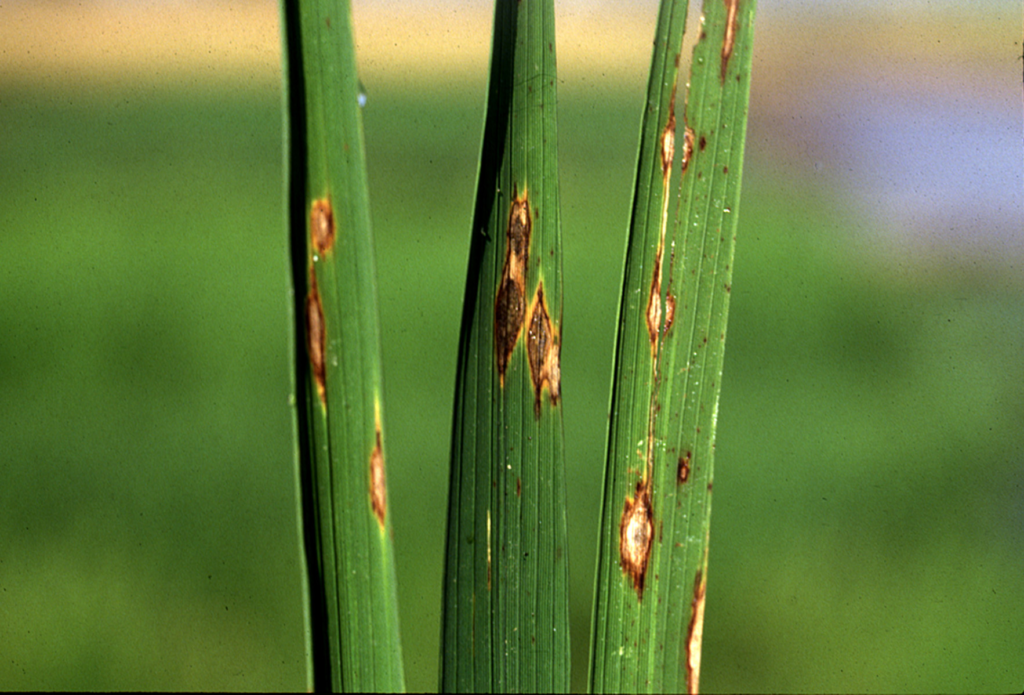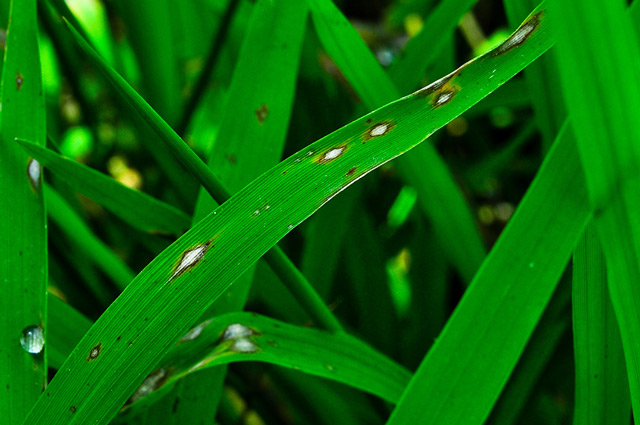In this article, we will delve into the comprehensive understanding of rice blast disease, covering its symptoms, disease cycle, and effective disease management strategies. By exploring these aspects, we aim to provide valuable insights into combating this devastating fungal disease and safeguarding rice production.
| Disease | Rice Blast |
|---|---|
| Hosts | Rice (Oryza sativa) |
| Pathogen | Magnaporthe oryzae (anamorph: Pyricularia oryzae) |
What is Rice Blast Disease
Rice blast disease, scientifically known as Magnaporthe oryzae, is a highly destructive fungal disease that poses a significant threat to rice crops worldwide. It primarily affects the leaves, stems, and panicles of rice plants, leading to substantial yield losses and endangering global food security.
The disease manifests as small, circular to oval lesions on various parts of the rice plant. Initially, these lesions appear as grey-green spots, which gradually enlarge and transform into necrotic or dead tissue. As the disease progresses, the lesions acquire a characteristic “blast” appearance, featuring a grey centre surrounded by a dark outer ring.

Rice blast disease has been detected in Western Australia, Queensland, and the Northern Territory; however, it remains exotic to the main rice-growing regions of southeastern Australia.
The disease’s occurrence is influenced by several factors. The blast spores are present in the air throughout the year, facilitating its spread. The disease is more prevalent in upland rice environments and at high elevations in tropical regions. Cloudy skies, frequent rain, and drizzles create favourable conditions for the disease.
Additionally, high levels of nitrogen, such as ammonium sulfate, can contribute to its development. Rice blast disease thrives in environments with high relative humidity (90% and higher) and wet leaves, with temperatures ranging from 25 to 28 degrees Celsius.
Rice blast disease is the earliest known plant disease and has been reported in 80 rice-growing countries. Its first recorded instance was in India in 1918. The disease can result in grain losses ranging from 70% to 80%.
Rice Blast Disease Symptoms

Symptoms of Rice Blast Disease:
Leaf Blast:
- White to grey-green lesions or spots with brown borders initially appear on the leaves.
- Small specks on the leaves subsequently enlarge into spindle-shaped spots, ranging from 0.5 to 1.5cm in length and 0.3 to 0.5cm in width, with an ashy centre.
- Older lesions become elliptical or spindle-shaped, whitish to grey, with necrotic borders.
- Several spots can coalesce, forming big irregular patches on the leaves.
- Lesions on leaves of susceptible cultivars rapidly expand to several centimetres in length, often with a darker green border.
- Resistant cultivars exhibit smaller lesions (1-2 mm) that remain brown to dark brown in colour.
Collar Blast:
- Infection occurs at the collar, which is the junction of the leaf and the stem sheath.
- Symptoms include a general area of necrosis at the union of the leaf and sheath.
- Collar infections can kill the entire leaf and extend a few millimetres into and around the sheath.
- The fungus may produce spores on these collar lesions.
Neck Blast:
- The neck refers to the portion of the stem that rises above the leaves and supports the seed head or panicle.
- Infection at the neck node leads to a condition called “rotten neck blast.”
- Neck infections can cause the panicle to fail, resulting in the seeds not filling (blanking) or the entire panicle rotting and falling over.
- Lesions on the neck appear greyish brown and cause girdling, leading to the collapse of the neck and panicle.
Nodal Blast:
- Infection occurs at the nodes of the rice plant.
- Infected nodes become black and break up.
Panicle and Grain Symptoms:
- Infections just below the panicle, particularly at the neck node, result in a “neck rot” or “rotten neck blast” symptom.
- Neck rot can cause premature death of the entire panicle, leaving it white and completely blank.
- Later infections may result in incomplete grain filling and poor milling quality.
- Panicle branches and glumes may also become infected, typically appearing brown or black.
Seed Symptoms:
- The fungus has been isolated from the pedicels of seeds.
- Infected pedicels can cause a condition called “blanking,” where no seeds are produced.
- Symptoms on seeds themselves include brown spots, blotches, and occasionally the classic diamond-shaped lesions seen on leaves.
- The exact process and timing of seed infection by the pathogen’s spores are not fully understood, but it is believed that the fungus can infect seeds by targeting the florets as they mature into seeds.
Blast Lesions on Leaf Sheaths:
- Lesions similar to those found on leaves can also appear on the leaf sheaths, the protective covering of the stem. These lesions cause browning or greyish discolouration.
Appressoria and Spores:
- The fungus produces appressoria, which are small, dark, dome-shaped structures on the plant surface before penetration occurs.
- Additionally, the fungus produces white or greyish spores called conidia, which can be observed on infected plant parts, especially during humid conditions, as powdery masses.
It is important to note that the size and shape of the spots may vary among different rice varieties. Identifying and understanding these symptoms is crucial for accurate diagnosis and effective management of rice blast disease.
Rice Blast Disease Cycle and Epidemiology:
Rice blast disease is caused by the fungus Magnaporthe oryzae, and has a complex disease cycle that involves various stages and modes of infection. Understanding the rice blast disease cycle and epidemiology is essential for implementing effective management strategies. Here is a detailed explanation of the disease cycle and the key aspects of rice blast epidemiology:

I. Disease Cycle:
- Initial Infection:
- The rice blast disease cycle begins with the presence of fungal spores (conidia) that survive in crop residues, soil, and infected seeds from the previous season.
- Under favourable environmental conditions, such as high humidity and moisture, the spores germinate and produce specialized infection structures called appressoria.
- Appressorial Penetration:
- The appressoria attach to the plant surface, usually the leaves, and generate immense turgor pressure to penetrate the plant tissues.
- Penetration occurs through the natural openings (stomata) or direct penetration of the leaf cuticle.
- Infection and Lesion Development:
- Once inside the plant tissues, the fungus colonizes and spreads, causing damage and symptom development.
- The fungus produces branched structures called hyphae, which extend and invade the host cells.
- Lesions begin to develop on various plant parts, including leaves, leaf collars, necks, panicles, pedicels, and seeds.
- Lesions initially appear as small, circular to oval spots and progressively enlarge, forming characteristic spindle-shaped or elliptical lesions with necrotic borders.
- Spore Production and Dissemination:
- The fungus produces asexual spores (conidia) within the lesions, which are easily spread by wind, water, and human activities.
- Conidia are the primary means of disease dissemination within the field and to neighbouring plants.
- Secondary Infections:
- Secondary infections occur when conidia land on healthy plant tissues and initiate new infections, leading to the development of additional lesions and disease spread.
- Secondary infections can result in multiple disease cycles during a single growing season.
II. Epidemiology:
- Environmental Factors:
- Rice blast disease is favoured by specific environmental conditions, including high humidity (above 90%), prolonged leaf wetness periods, and moderate temperatures (around 25-30°C).
- The disease spreads rapidly during the rainy season or in areas with frequent dew formation.
- Host Factors:
- The susceptibility of rice cultivars plays a crucial role in the disease epidemiology.
- Susceptible cultivars allow for easier infection and disease development, leading to higher disease incidence and severity.
- Resistant cultivars can impede disease progression and limit epidemic development.
Rice Blast Disease Control/Management
I. Cultural Methods:
Crop Rotation:
- Crop rotation is a highly recommended technique to manage rice blast.
- It involves planting different crops in successive seasons, which helps separate viable spores in crop residues from newly emerging seedlings.
- By breaking the disease cycle, crop rotation reduces the risk of disease carryover and initial inoculum.
Proper Fertilization:
- Rice producers are urged to fertilize different rice cultivars properly.
- Overuse of nitrogen fertilizers should be avoided, as it can increase the severity of rice blast without significant yield benefits.
- Following appropriate fertilization practices helps maintain a balance between crop growth and disease susceptibility.
Maintaining Proper Flood Levels:
- Rice blast is known to be more severe in fields or parts of fields where the water level falls below recommended levels.
- Rice producers should ensure a proper flood level for the rice to grow, as it helps reduce disease severity.
- Adequate irrigation practices are crucial to create an environment less favorable for the development and spread of rice blast.
Using High-Quality Seed:
- The use of high-quality and disease-free seed is highly recommended.
- Infested seeds left on the soil surface can serve as a source of inoculum, leading to disease epidemics.
- Using disease-free seed reduces the risk of introducing the pathogen into the field and helps prevent disease outbreaks.
II. Genetic Resistance:
Planting Resistant Varieties:
- Planting rice cultivars that possess genetic resistance against rice blast is an effective and economical method of disease control.
- However, it is important to note that the pathogen exhibits genetic variability, and new races can emerge, rendering previously resistant cultivars susceptible.
- Continuous monitoring and deployment of cultivars with multiple resistance genes are necessary to combat the evolving races of the pathogen.
III. Biological Control Methods:
Introduce biological agents such as Izumonas and Izumil, which offer promising solutions for disease management.
Introducing Izumonas and Izumil for Rice Blast Disease Management Izumonas and Izumil are effective biotechnological research products specifically developed to combat rice blast disease. These products provide innovative biological approaches to enhance plant defence mechanisms and promote crop growth.
A. Izumonas
-
ड्रैगन फ्रूट की खेती कैसे करें (Dragon Fruit Ki Kheti Kaise Karein)
ड्रैगन फ्रूट आजकल बहुत प्रसिद्ध हो रहा है। शुरुआत में, कुछ किसान ही इस फल की खेती करते थे, लेकिन अब देखा जा रहा है कि और भी किसान इसमें रुचि ले रहे हैं। भारत के कई राज्यों में इसकी खेती बढ़ रही है। शुरुआत में, किसानों को इसकी खेती
-
गाजर की खेती कैसे करें( Gajar ki kheti kaise Karein)
गाजर एक पौधा है जो हर दो साल में फसल देता है. यह एक पौधा है जो “अंबेलिफर कुटुंब” से संबंधित है, और इसका पूरा जीवन चक्र एक या दो साल में पूरा होता है. गाजर विटामिन ए का बड़ा स्रोत होता है और यह भारत की मुख्य सब्जी की
-
मूंगफली की खेती कैसे करें : बुवाई से लेकर कटाई तक
आपका स्वागत है! हम आपको मूंगफली की खेती के बारे में विस्तारपूर्ण जानकारी देंगे, ताकि आप इसे अपने खेत में उगा सकें। मूंगफली भारत में महत्वपूर्ण फसल है, जिसकी खेती देश के तकरीबन सभी राज्यों में की जाती है। लेकिन इसकी फसल उत्तराखंड और दिल्ली जैसे राज्यों में बेहतर फलती
-
गेहूं की खेती कैसे करें (Gehu Ki Kheti Kaise Karein): उन्नत उपज और उपयोगी सुझाव
भारत में गेहूँ की खेती एक महत्वपूर्ण फसल की कई बातें सिखने के लिए बेहद महत्वपूर्ण है। यह फसल भारतीय कृषि क्षेत्र का मुख्य हिस्सा है और इसकी कटाई से लाखों लोग अपने जीवन का अधिकतम हिस्सा प्राप्त करते हैं। गेहूँ का महत्व: गेहूँ को भारत में ‘आन्न’ का राजा
-
धान की खेती कैसे करें (Dhan ki kheti) – बुवाई से लेके कटाई तक की संपूर्ण जानकारी
धान, भारत समेत कई एशियाई देशों की मुख्य खाद्य फसल है। दुनिया के अन्य क्षेत्रों में भी मक्का के बाद धान की खेती की जाती है। करोड़ों किसान धान की खेती करते हैं, खासकर खरीफ सीजन में भारत के विभिन्न हिस्सों में धान की खेती की जाती है। धान की
Contents:
- Pseudomonas fluorescens, a plant growth-promoting rhizobacteria (PGPR).
Functions:
- Strengthens the plant’s defence mechanism.
- Supports various growth processes.
B. Izumil
-
ड्रैगन फ्रूट की खेती कैसे करें (Dragon Fruit Ki Kheti Kaise Karein)
ड्रैगन फ्रूट आजकल बहुत प्रसिद्ध हो रहा है। शुरुआत में, कुछ किसान ही इस फल की खेती करते थे, लेकिन अब देखा जा रहा है कि और भी किसान इसमें रुचि ले रहे हैं। भारत के कई राज्यों में इसकी खेती बढ़ रही है। शुरुआत में, किसानों को इसकी खेती
-
गाजर की खेती कैसे करें( Gajar ki kheti kaise Karein)
गाजर एक पौधा है जो हर दो साल में फसल देता है. यह एक पौधा है जो “अंबेलिफर कुटुंब” से संबंधित है, और इसका पूरा जीवन चक्र एक या दो साल में पूरा होता है. गाजर विटामिन ए का बड़ा स्रोत होता है और यह भारत की मुख्य सब्जी की
-
मूंगफली की खेती कैसे करें : बुवाई से लेकर कटाई तक
आपका स्वागत है! हम आपको मूंगफली की खेती के बारे में विस्तारपूर्ण जानकारी देंगे, ताकि आप इसे अपने खेत में उगा सकें। मूंगफली भारत में महत्वपूर्ण फसल है, जिसकी खेती देश के तकरीबन सभी राज्यों में की जाती है। लेकिन इसकी फसल उत्तराखंड और दिल्ली जैसे राज्यों में बेहतर फलती
-
गेहूं की खेती कैसे करें (Gehu Ki Kheti Kaise Karein): उन्नत उपज और उपयोगी सुझाव
भारत में गेहूँ की खेती एक महत्वपूर्ण फसल की कई बातें सिखने के लिए बेहद महत्वपूर्ण है। यह फसल भारतीय कृषि क्षेत्र का मुख्य हिस्सा है और इसकी कटाई से लाखों लोग अपने जीवन का अधिकतम हिस्सा प्राप्त करते हैं। गेहूँ का महत्व: गेहूँ को भारत में ‘आन्न’ का राजा
-
धान की खेती कैसे करें (Dhan ki kheti) – बुवाई से लेके कटाई तक की संपूर्ण जानकारी
धान, भारत समेत कई एशियाई देशों की मुख्य खाद्य फसल है। दुनिया के अन्य क्षेत्रों में भी मक्का के बाद धान की खेती की जाती है। करोड़ों किसान धान की खेती करते हैं, खासकर खरीफ सीजन में भारत के विभिन्न हिस्सों में धान की खेती की जाती है। धान की
Contents:
- Extract of Streptomyces griseus (30%) and extract of Streptomyces violaceus (40%), with dissolving agents (30%).
Functions:
- Activates the plant’s natural defence mechanism.
- Enhances crop physiology and resilience against various pathogens.
How to Use
Suitable for all crops and leaves no residue.
- Seed Treatment: Mix 5-10 ml of Izumonas and 5-10 ml of Izumil per kg of seed in sufficient water. Treat the seeds in the combined solution, then shade dry before sowing.
- Seedling Treatment: Mix 100 ml of Izumonas and 100 ml of Izumil per 20 litres of water. Dip the roots of the seedlings for approximately 30 minutes in the combined solution before transplanting.
- Soil Application: Mix 500 ml of Izumonas and 500 ml of Izumil with 30 kg of FYM/soil and apply in 1 acre before ploughing or irrigation.
- Foliar Application: Dilute 2-3 ml of Izumonas and 2-3 ml of Izumil in 1 litre of water and thoroughly spray the foliage.
For best results, shake both bottles before use and ensure complete coverage of the plant’s foliage. It is recommended to spray early in the morning or evening for optimal effectiveness. In the case of using a power sprayer, double the recommended dose for both products.
IV. Integrated Management:
Integration of Strategies:
- Successful rice blast management relies on the integration of multiple strategies and techniques.
- Cultural practices, resistant varieties, and judicious use of fungicides should be combined to achieve effective disease control.
- Implementing a comprehensive management plan ensures better long-term management and reduces the risk of crop failure.
V. Significance of the Disease:
Impact on Rice Production:
- Rice blast is the most significant disease affecting rice, which serves as a staple food crop for a large population worldwide.
- Epidemics of rice blast can lead to crop failures and result in significant economic losses.
- Despite extensive research and management efforts, complete eradication of rice blast from rice-growing regions has not been achieved.
Model Disease for Research:
- Rice blast has been widely studied and serves as a model disease for understanding various aspects of plant pathology.
- Research on rice blast has contributed to advancements in genetics, epidemiology, molecular pathology, and host-parasite interactions.
- The sequencing of the rice blast fungus genome has provided valuable insights into its biology and facilitated research on other plant diseases.
In conclusion, effective management of rice blast requires the implementation of cultural practices, genetic resistance, and chemical methods in an integrated manner. By following the recommended strategies, rice producers can significantly reduce the impact of this devastating disease. However, it is crucial to remember that vigilance and careful monitoring are necessary throughout the growing season.

